Buddhism in Ancient Egypt and Meroe – Beliefs Revealed Through Ancient Script
Did Buddhism exist in Upper Egypt and the Lower Meroitic Empire? The answer appears to be yes. It was in Memphis that English Egyptologist and archaeologist W. M. Flinders Petrie found evidence of Buddhist colony.
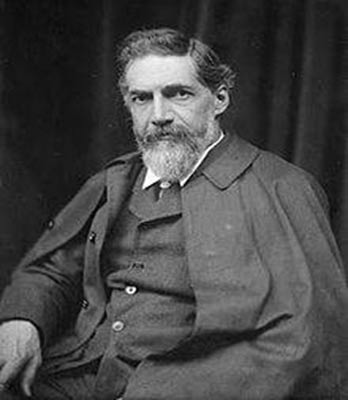
Portrait of Sir William Matthew Flinders Petrie, 1903. (Public Domain)
The Buddhist Colony
Flinders Petrie claimed these Buddhists dated back to the Persian period of Egypt (circa 525-405 BC). He wrote:
"on the right side, at the top is the Tibetan Mongolian, below that the Aryan woman of the Punjab, and at the base a seated figure in Indian attitude with the scarf over the left shoulder. These are the first remains of Indians known on the Mediterranean. Hitherto there have been no material evidences for that connection which is stated to have existed, both by embassies from Egypt and Syria to India, and by the great Buddhist mission sent by Ashoka as far west as Greece and Cyrene. We seem now to have touched the Indian colony in Memphis, and we may hope for more light on that connection which seems to have been so momentous for Western thought”.
If Petrie's dating is correct this puts Buddhists in Egypt two hundred years before Ashoka sent Buddhist missionaries to Egypt.
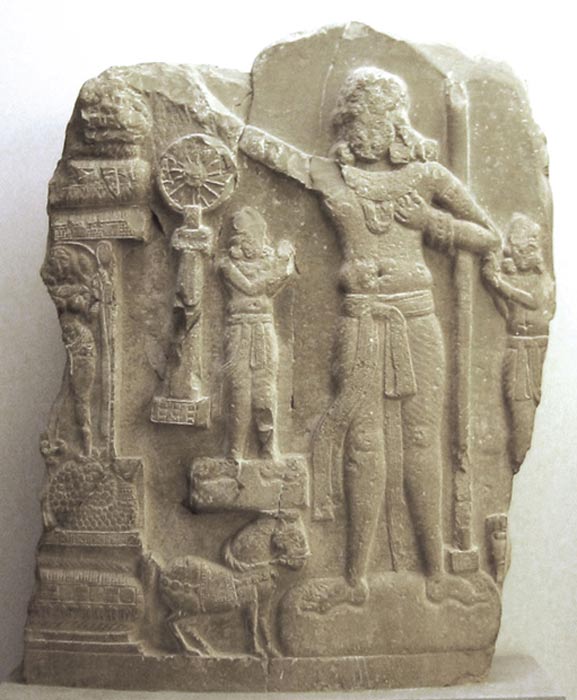
A circa 1st century BCE/CE relief from Amaravati, Andhra Pradesh (India). The figure in the center may represent Ashoka. (CC BY-SA 3.0)
Ashoka was a king of India who worshipped Buddhism. Ashoka sent out edicts throughout his empire encouraging people to adopt Buddhism as a way of life written in various languages.
Ashoka Rock Inscription
Ashoka built a temple at Sarnath, which is called Lion Capital of Ashoka. In Buddhism lions represent the bodhisattvas, the "sons of the Buddha". The bodhisattvas are beings who have attained a high degree of spiritual development.

Ashoka lions at Sarnath, 1911. (Public Domain)

Monastery around Dhamek stupa, Sarnath. (CC BY 2.0)
In Philostratus: The Life of Apollonius of Tyana it is made clear that the Gymnosophist lived in Upper Egypt and the Meroitic Empire. The Gymnosophists were Buddhists. The historical evidence makes it clear that there were probably two migrations of Buddhist Gymnosophists to Egypt and the Meroitic Empire.
Ashoka was a supporter of Buddhism. Zacharias P. Thundy, in Buddha and Christ makes it clear that the edicts of Ashoka (circa 274-236 BC) indicate that this ruler sent missionaries to Egypt to preach the Buddhist Dharma.

Ashoka's Major Rock Edict at Junagadh contains inscriptions by Ashoka (fourteen of the Edicts of Ashoka), Rudradamanna I and Skandagupta. (CC BY-SA 3.0)

Bilingual inscription (Greek and Aramaic) by king Ashoka, from Kandahar. (Public Domain)
Thundy maintains that archaeological evidence exist for a community of Indian sages living in Memphis as early as 200 BC. We know that descendants of these missionaries were still in Egypt over two hundred years later because they were visited by Apollonius of Tyana.
- Ashoka the Great: From Cruel King to Benevolent Buddhist
- Nubia and the Powerful Kingdom of Kush
- Ancient Tomb Reveals Cultural Entanglement between Egypt and Nubia
Ashoka used the ancient script Kharosthi to write his edicts. The Buddhist also used this writing system to record their scriptures. This means that the Gymnosophists would have had a long tradition of employing Kharosthi to communicate their ideas. The Gymnosophists were probably well respected by the Meroites and some Meroites probably had knowledge of Buddhist teachings and literacy.
The Appearance of Blemmyae
Some Meroites may have played an important role in Buddhism because Blemmyae, a prominent group in the Meroitic Sudan are mentioned in Pali text Tipitaka.
Dr. Derrett wrote that in the early Pali text “we have a Blemmya (an African) in front rank Buddhist texts of very respectable age. The Buddhist text where Blemmya were mentioned are very old. The Vinaya Pitaka, is dated to the fourth century BCE.
If Blemmya are mentioned in Buddhist text, we can be sure that Meroites (ancient kingdom of Kush) were not ignorant of Kharosthi. This would explain why many of the Meroitic symbols agree with Kharosthi. They agree because some Meroites were probably already literate in Kharosthi due to the influence of Buddhism in the Meroitic Empire.
There seems to have been a second migration of Buddhists to the Meroitic Empire many years after Ashoka sent missionaries to Egypt. These migrants came to the Meroitic Empire after their king was murdered.
Gymnosophists spread Buddhism in the Nile Valley
Flavius Philostratus, the writer of the Vita Apollonii, Vol.1, claimed that the Gymnosophists of Meroe originally came from India. The fact that the Kushana had formerly ruled India around the time that the Meroitic writing was introduced to the Kushite civilization, led to the hypothesis that the ancestors of the Gymnosophist may have been Kushana philosophers. The historical evidence of the Kushana having ruled India made the Classical references to Indians, the Gymnosophists in Meroe, an important source for the construction of alternative theories about the possible location of the cognate language of Meroitic.
There is external evidence which supports my theory that the Gymnosophists spread Buddhism in the Nile Valley, and the Meroites adopted Khrosthi as the model for the Meroitic script. A theory explains observed phenomena and has predictive power. I have theorized that due to the claims of the Classical writers that some of the Meroites came from India. According to Philostratus the Life of Apollonius of Tyana , the Indian Meroites were formerly led by a King Ganges, who had “repulsed the Scythians who invaded this land [India from] across the Caucasus”. Philostratus also made it clear that the Indians of Meroe came to this country after their king was killed.
- Hidden Beliefs Covered by the Church? Resurrection and Reincarnation in Early Christianity
- Kathmandu: How Religion and Trade Flowed into an Ancient Water-Filled Valley
- What Does Alexander the Great Have to Do with Buddhist Imagery?
The presence of this tradition of an Indian King of the Indian-Meroites conquering the Scythians predicts that the Indian literature should record this historic episode. This prediction is supported by a Jaina text called the Kalakeharya-Kathanaka, which reports that when the Scythians invaded Malwa, the King of Malwa, called Vikramaditya defeated the Scythians. This king Vikramaditya may be the Ganges mentioned in the Life of Apollonius. Confirmation of the Ganges story supports the Classical literary evidence that there were Indianized-Meroites who could have introduced the Tocharian trade language to the Meroites.

Wooden plate with inscriptions in the Tocharian language. Kucha, China, 5th–8th century. (Public Domain)
In addition to the classical mention of the Indians settling Meroë, and Ashoka's edict sending missionaries to Egypt, we also have a horde of Kushana coins that were found on the floor of a cave at the present monastery-shine at Debra Demo in modern Ethiopia in 1940. The Kushana were Buddhists that lived in Central Asia and India.

At Meroë, pyramids of the Kushite rulers. (CC BY-SA 1.0)
If there were Gymnosophist communities in Upper Egypt and the Meroitic Sudan, there should be evidence of Buddhist influence in the region.
Meroitic Lion-Headed God
Considerable evidence of Buddhism in ancient Meroe or Kush is in the form of Meroitic iconography and the Meroitic script.
Much of the Buddhist influence surrounds the Meroitic God Apedemak. Apedemak was the lion God of the Meroites, worshiped by many.

The lion-headed god Apedemak. The name of King Tantamani in Meroitic script is written on the back. Circa 100 BCE, Sandstone. (CC BY-SA 2.0 fr)
Meroitic temples dedicated to Apedemek have been found at Meroe, Musawwarat es-Sufra, and Naqa. At the temple of Naqa we see a number of examples of Buddhist influence. Here, Apedemak was depicted as a three-headed leonine god with four arms, and as a snake coming out of a lotus with a lion head.
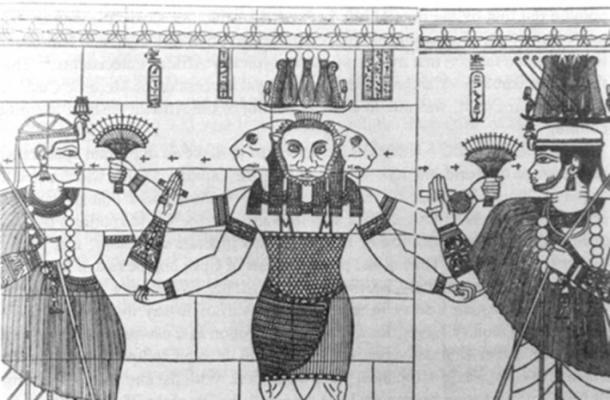
Apedemak depicted as a three-headed leonine god with four arms. (Public Domain)
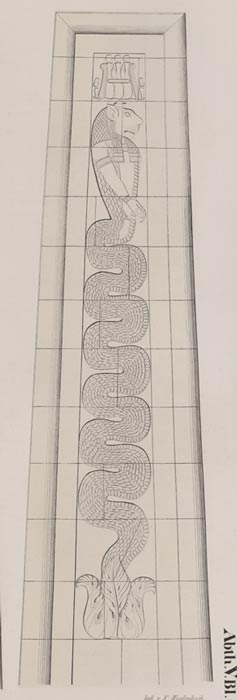
Apedemak depicted as a snake coming out of a lotus with a lion head. (Public Domain)
In India, the Gymnosophists used Tocharian and the Kharosthi script to write their scriptures. This makes it clear that Tocharian and Kharosthi were important means of communication for this Meroite population. Tocharian was therefore probably a major language in the Meroitic Sudan.
The Tocharian language was written in Kharosthi script. This script was used to write the Gandhararan Buddhist Text. According to Glass, the Kharosthi script appears fully developed in the Ashokan inscriptions of Shahbazgarhi and Mansehra. These inscriptions date back to third century BC. It continued to be used in Gandhara, Kushan and Sogdian.
Glass provides evidence that Kharosthi writing dates back to the first Brahmi inscriptions of India. The fact the writing was used in India by Ashoka to produce the rock edicts demonstrates that Khasrothi was in use long before the introduction of the Meroitic script to Kush.
The Meroitic script resembles many Khaorsthi signs. Some researchers argue that the Meroites did not adopt the writing system of the Kushana/Tocharian people which was Kharosthi. Although this is their opinion, a comparison of the Meroitic and Kharosthi symbols make it clear that both writing systems share many cognate signs.
Aubin did a comparison of Meroitic and Kharothi and discovered that 34 out of 42 signs, or 81 percent, matched.
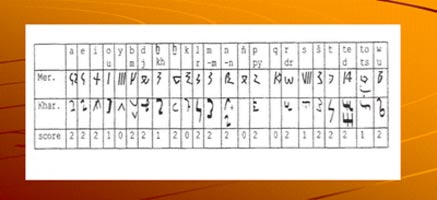
Aubin (2003) Comparison of Meroitic and Kharosthi Signs
Since Tocharian was written in Kharosthi, the cognition between Kharosthi and Meroitic is quite interesting and shows some connection between these scripts. It also offers additional support to the Tocharian origin of Meroitic writing given the analogy between the signs.
Let's not forget that Welsby, in The Kingdom of Kush, notes that “only four of the [Meroitic] letters resemble the equivalent Egyptian demotic signs.” But as you can see from the above there are more than four Kharosthi signs that match Meroitic, and even more of these signs match Kharosthi.
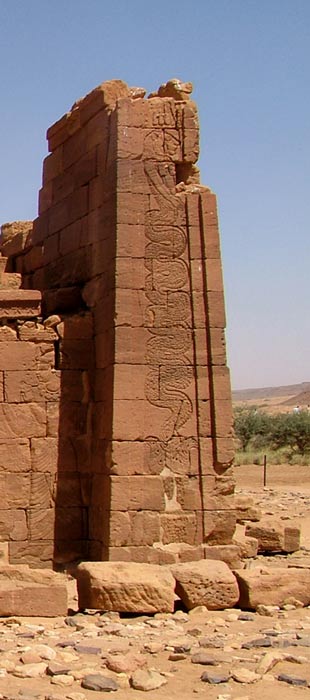
Temple exterior showing Apedemak as a snake coming out of a lotus with a lion head. (Public Domain)
The History of a Language
Moreover, there were other Indians in Egypt in addition Gymnosophist/Buddhist communities in Upper Egypt and Kush/Meroe. For example, at Quseir al-Qadim there was a large Indian speaking community. These Indians were in Egypt writing messages in their own language around the time we see a switch from Egyptian hieroglyphics to the Meroitic writing system. All of this supported the Classical traditions of the Meroites that speak of a knowledge of the Kushana/Indians among the Meroites.
The evidence that the Classical references to an Indian-Meroite King who conquered the Scythians is supported by the Indian literature, provides external corroboration of the tradition that some of the Meroites were of Indian origin.
The presence of Indian traders and settlers in Meroe (and Egypt), makes it almost impossible to deny the possibility that Indians, familiar with the Tokharian trade language, did not introduce this writing to the Meroites who needed a neutral language to unify the diverse ethnic groups which made up the Meroite state. In relation to the history of linguistic change and bilingualism, it is a mistake to believe that linguistic transfer had to take place for the Meroites to have used Tokharian, when it did not take place when the Meroites wrote in Egyptian hieroglyphics.
It is obvious that Buddhism was worshipped in the Meroitic Empire or Kush. This is supported by 1) the presence of Kushites in Africa and Asia; 2) Ashoka sent many Buddhist missionaries to Egypt who wrote their scriptures in Kharosthi and Tocharian; 3) a Blemmya—native to the Meroitic empire, is mentioned in numerous Buddhist Pali texts; 4)the presence of Kushana sages in India who may have migrated to Meroe; 5) the presence of a Buddhist colony at Memphis, Egypt, 6) Buddhist iconography at the Naqa Temple of Apedemek, and 7) Classical references to Buddhists in Egypt and the Meroitic Empire proves that Buddhism was practiced in Egypt and Kush.
The historical evidence makes it clear that the Meroites were probably not strangers to Kharosthi literacy since the Gymnosophists had been in Upper Egypt and the Meroitic Empires for hundreds of years before the Meroites invented the Meroitic script.
--
Top Image: Deriv; Pyramid of Cheops behind Chephren, Giza, Egypt (CC BY 2.0), inscription from Kandahar (Public Domain), and Buddha (CC BY 2.0)
Updated on December 15, 2021.
References
W. M. Flinders Petrie, The peoples of the Persian Empire, Man (1908) No.71:pp.129-130.
JDM Derrett, (2002) A Blemmya in India, Numen 49:460-474
F.C. Conybeare, Philostratus:The Life of Apollonius of Tyana(p.45),1950.
H. Kulke & D. Rothermund, History of India(London, Routledge: 1990, pg.73 .
Glass, A. (2000). A Preliminary Study of Kharosthi Manuscript Paleography, ( M.A. Thesis.
University of Washington) pp.20-21
Aubin,P. (2003). Evidence for an Early Nubian Dialect in Meroitic Inscriptions: Phonological and
Epigraphic Considerations. Meroitic Newsletter, pp.16-39.
R. Salomon, "Epigraphic remains of Indian traders in Egypt", Journal of the American Oriental Society, (1991) pp.731-736; and R. Salomon, Addenda, Journal of the American Oriental Society, (1993) pg.593 .
Clyde Winters, Meroitic Writing and Literature. Createspace, 2013.
















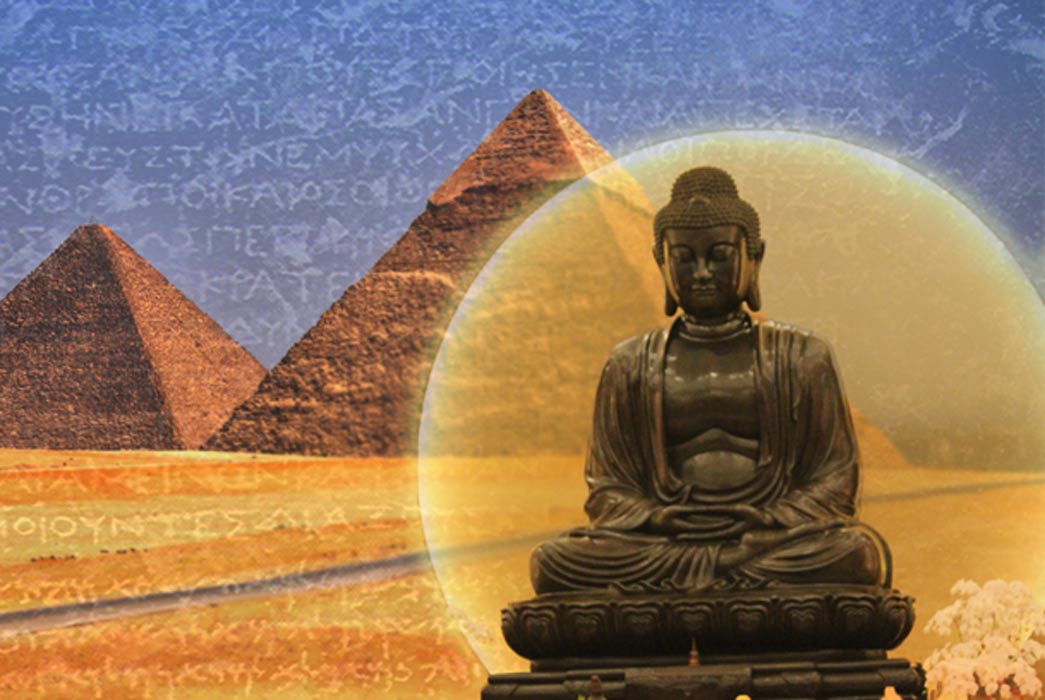

Comments
@slowmo Very possible. More so, when you consider the (three) wise men who visited him before he went to Egypt, after they saw signs in the heavens. Think on how the Panchen Lama was selected for example. Then look at sayings and teachings like "the kingdom of heaven is within you"; the "Gospel of Thomas", his debate with Jewish scholars in the temple when he was only 12, and his apparently pacifist life. It is very possible.
--
Robertus
My dear friends, the answer is very clear if you open your minds, eyes and spirit. Take a good look at the Buddhist sculpture. It is an AFRICAN being sitting in such pose. First of all, the hair style is of African decent, which is called Bantu knots that originated in South Africa. This style was worn in various countries in Africa and currently worn and embraced in the African/African American natural hair community. Secondly, look closely at the Buddha's earlobe. Again, that is an African tradition which started with the
Maasai tribe in Kenya centuries ago. Presently, this practice of tradition has now been passed on to Australians, Europeans, Asians, and Americans. Lastly, I am a first generation African American, but was raised traditionally by my parents. They taught me among other things the ability to look at another African person features and bone structure and determine their origin.This is something all Africans are taught. So, I say unto you all to look up the information and study visually as well as research information with an open mind and spirit.
Perhaps the world is ready to learn that all religions flow from Hinduism in every respect, to include the Abramic (Brahma); Judaism, Christianity and Islamic, and that YHWH is none other than Shiva. In fact, the 'Jews' or Jooees, are known to have arrived from India as an offshoot of Hinduism long ago, settling in northern Syria as the Hyksos and Hyklos. They've always been the proto-Israelites and nothing will ever change it.
We owe much to India and her people as an obvious cradle of humanity and home to the oldest religion on this planet, a well as some of the most intelligent and beautiful people this earth has ever known. Without India and Kerala as but one learning center, Pythagorus would never have learned what little he did. Apollonius studied in India as did Jesus. Apollonius was a Therapeutae and an Essene.
Egypt owes its religion and its pyramidal architects to India, as does every civilization on this planet.
Thank you for the wealth of knowledge you've shared, and demand your wealth stolen by England finally be returned to its rightful owners, unless we're unsure why the UK is fading into the sunset in true karmic fashion.
Namaste.
Thanks for your comments, and the reference to the Patrick Robiano paper. The article is good but it does not deny the existence of Buddhism in Kush and Egypt, it just explained how the Gymnosophist were presented by Philostratus and Heliodorus in their works about the Meroites.
You claim that this article fails to illustrate the existence of Buddhism in Egypt and Kush, but I explained in the article that much of the Buddhist influence surrounds the worship of the Meroitic God Apedemak. At the temple of Naqa we see a number of examples of Buddhist influence, e,g., Apedemak depicted as a three-headed leonine god with four arms; also at the Temple, Apedemak is represented as a snake coming out of a blossoming lotus with a lion head. These are all symbols of Buddhism.
The lotus in Buddhism represents purity of mind and body; the open blossom represents full enlightenment. Other Buddhist elements in Meroitic society was the footprint, elephants and Swastika seen in Meroitic iconography, and the influence of Kharosthi on the Meroitic script. The Swastika in Buddhism means good luck, it is represented on the Stela of Meteya, published in my book Archaeological Decipherment of Ancient Writing Systems, page 131. The Elephant represented strength of the mind and gentleness. Finally footprints are found at numerous Meroitic sites; in Buddhism footprints represent the presence of Enlightenment , and represents the pilgrimage of the follower of Buddhism at Meroite temples. None of these religious ideas and symbolism are associated with Hinduism. You can find out more about Buddhism in Meroe in my book Meroitic Writing and Literature at https://www.amazon.com/Meroitic-Writing-Literature-Clyde-Winters/dp/0615...
No direct evidence that buddhism was present in Egypt or Meroe is listed in the article. What if the Indians depicted by statuettes were followers of contemporary form of hinduism? And how do we know that gymnosophists were buddhists, not hinduists? http://www.persee.fr/docAsPDF/rea_0035-2004_1992_num_94_3_4507.pdf Many references on the topic are missing, e.g. book by I. Hoffmann "Wege und Möglichkeiten eines indischen Einflusses auf die meroitische Kultur" and proceedings India and Egypt of the conference held in 1991 in Cairo https://www.amazon.com/India-Egypt-Interactions-Saryu-Doshi/dp/8185026238
Pages